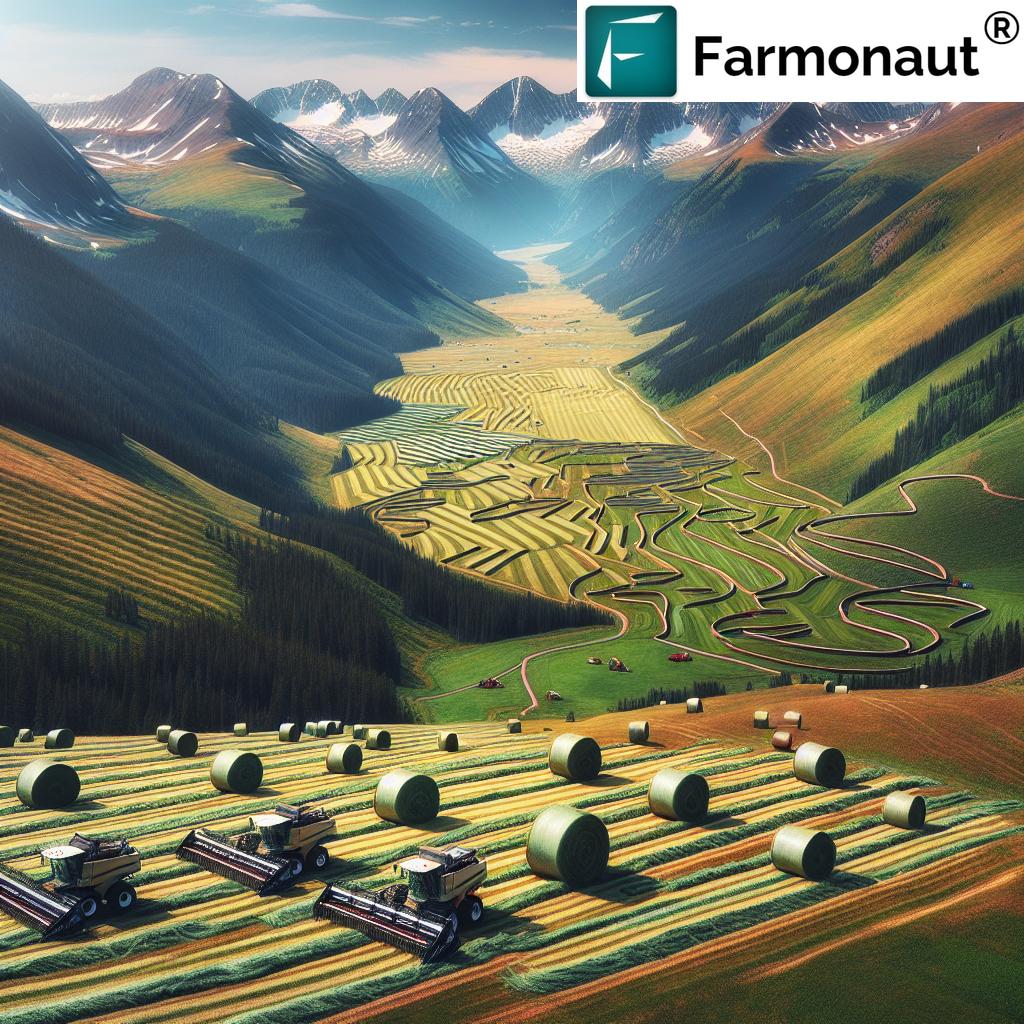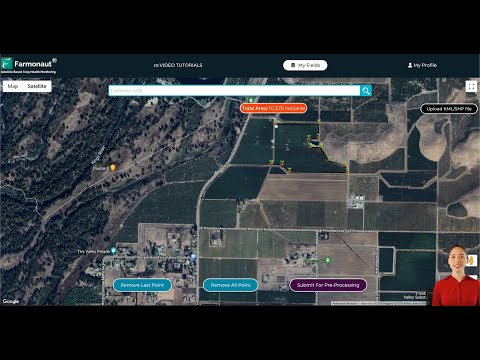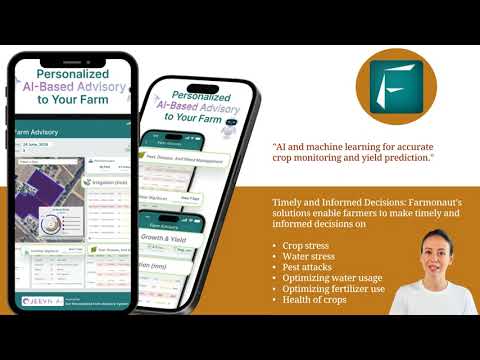Mastering High-Altitude Hay: Resilient Farming Techniques in Colorado’s Alpine Valleys
“Colorado’s alpine hay farmers produce high-quality forage at elevations up to 10,000 feet, defying extreme weather conditions.”
Welcome to the breathtaking world of high-altitude hay farming in Colorado’s scenic mountain valleys! We’re about to embark on an exciting journey through the unique challenges and triumphs of alpine agriculture. In this comprehensive guide, we’ll explore how ranchers navigate extreme weather, utilize century-old irrigation systems, and produce top-notch forage at elevations that would make most farmers dizzy.
As we delve into the intricacies of mountain valley irrigation and the latest in hay baling equipment for alpine farms, we’ll uncover how precision agriculture techniques and climate-adaptive farming methods are revolutionizing operations in these challenging terrains. Whether you’re a farming enthusiast or simply curious about life in the high country, this blog will provide you with a fascinating glimpse into the world of high-altitude agriculture.

The Unique Challenges of High-Altitude Hay Farming
High-altitude hay farming in Colorado’s alpine valleys is a testament to human resilience and agricultural innovation. Let’s explore the unique challenges that these intrepid farmers face:
- Extreme Weather Conditions: At elevations up to 10,000 feet, weather patterns can be unpredictable and severe. Farmers must contend with sudden temperature drops, early frosts, and intense UV radiation.
- Short Growing Seasons: The alpine climate limits the growing season to just a few precious months, typically from late May to early September.
- Soil Challenges: Rocky, thin soils are common in mountain valleys, requiring careful management and nutrient supplementation.
- Water Management: While snowmelt provides abundant water in spring, efficient irrigation is crucial during the drier summer months.
Despite these challenges, high-altitude hay farmers in Colorado have developed ingenious methods to not only survive but thrive in this harsh environment. Their success is a testament to the power of human innovation and the resilience of agricultural communities.
Century-Old Irrigation Systems: A Marvel of Engineering
“Century-old irrigation systems are still utilized in Colorado’s mountain valleys, showcasing the resilience of traditional farming methods.”
One of the most fascinating aspects of high-altitude hay farming in Colorado is the continued use of century-old irrigation systems. These marvels of engineering have stood the test of time, proving that sometimes, the old ways are the best ways.
- Gravity-Fed Systems: Many of these irrigation networks rely on gravity to distribute water across the fields, requiring minimal energy input.
- Intricate Canal Networks: A complex web of canals and ditches, often hand-dug by early settlers, ensures water reaches every corner of the farmland.
- Communal Management: In many areas, these systems are managed communally, with farmers working together to maintain and optimize water distribution.
While these traditional systems continue to serve farmers well, modern technology is being integrated to enhance their efficiency. For instance, Farmonaut’s satellite-based crop health monitoring can help farmers optimize their water usage by providing real-time data on soil moisture levels.
Climate-Adaptive Farming: The Key to Success
In the face of climate change and unpredictable weather patterns, high-altitude hay farmers in Colorado have become masters of adaptation. Here are some of the climate-adaptive farming techniques they employ:
- Diverse Crop Selection: Farmers often cultivate a mix of grass species that can withstand varied conditions, ensuring at least some crops survive in any given year.
- Precision Seeding: Using advanced equipment, farmers can plant seeds at optimal depths and spacing, maximizing germination rates and crop yields.
- Soil Conservation: Techniques like strip tillage and no-till farming help preserve soil structure and retain moisture in the arid mountain climate.
- Microclimate Utilization: Savvy farmers take advantage of small-scale climate variations within their land, planting different crops in areas with slightly different conditions.
These adaptive techniques, combined with cutting-edge technology like Farmonaut’s AI-powered Jeevn advisory system, allow farmers to make data-driven decisions that optimize their yields even in challenging conditions.
The Art and Science of High-Altitude Hay Production
Producing high-quality hay at altitude is both an art and a science. Let’s delve into the unique aspects of this process:
Timing is Everything
In the short alpine growing season, timing each step of the hay production process is crucial:
- Spring Thaw: Farmers must be ready to start as soon as the snow melts and the ground thaws.
- First Cut: Typically in late June or early July, depending on elevation and weather conditions.
- Second Cut: If conditions allow, a second cut may be possible in August, but this is not guaranteed every year.
Specialized Equipment for Alpine Terrain
High-altitude hay farming requires specialized equipment designed to handle the unique terrain and conditions:
- Compact Tractors: Smaller, more maneuverable machines that can navigate steep slopes and tight turns.
- Adjustable Mowers: Capable of adapting to uneven ground and varying grass heights.
- High-Capacity Balers: Efficient machines that can quickly process hay before weather conditions change.
Farmonaut’s fleet and resource management tools can help farmers optimize the use of this specialized equipment, ensuring maximum efficiency and minimal downtime.
The Unique Benefits of High-Altitude Hay
Despite the challenges, high-altitude hay farming offers some unique advantages:
- Superior Nutritional Content: The stress of high-altitude conditions can lead to higher protein content and increased nutritional value in the hay.
- Pest Resistance: Many common pests cannot survive at high altitudes, reducing the need for pesticides.
- Weed Control: The harsh climate naturally limits weed growth, resulting in cleaner, higher-quality hay.
- Unique Flavor Profile: Many ranchers believe that high-altitude hay imparts a distinctive flavor to the meat of animals that consume it.
These benefits make high-altitude hay a sought-after commodity, often commanding premium prices in the market.

Sustainable Ranch Management in the High Country
Sustainable ranch management is crucial in the delicate alpine ecosystem. Here are some key practices employed by high-altitude hay farmers:
- Rotational Grazing: Carefully managed grazing patterns help maintain soil health and grass diversity.
- Water Conservation: Efficient irrigation systems and water storage solutions help farmers make the most of limited water resources.
- Wildlife Corridors: Many ranchers maintain natural corridors for wildlife movement, preserving biodiversity.
- Carbon Sequestration: Proper grassland management can help sequester significant amounts of carbon, contributing to climate change mitigation.
Farmonaut’s carbon footprinting feature can help ranchers track their environmental impact and identify areas for improvement in their sustainability efforts.
The Role of Technology in High-Altitude Farming
While traditional knowledge remains crucial, modern technology is playing an increasingly important role in high-altitude hay farming:
- Satellite Imagery: Farmonaut’s satellite-based crop health monitoring provides invaluable insights into vegetation health and soil moisture levels.
- Weather Forecasting: Advanced local weather predictions help farmers plan their activities with greater precision.
- Soil Sensors: In-ground sensors provide real-time data on soil conditions, helping optimize irrigation and fertilization.
- Drone Technology: Drones equipped with multispectral cameras can provide detailed crop health assessments.
These technological advancements are helping high-altitude farmers make more informed decisions and optimize their operations like never before.
The Economic Impact of High-Altitude Hay Farming
High-altitude hay farming plays a crucial role in the economy of Colorado’s mountain communities:
- Local Employment: These farms provide valuable job opportunities in rural areas.
- Tourism: The picturesque hay fields contribute to the region’s scenic beauty, attracting tourists.
- Supply Chain: High-quality hay supports local livestock industries and is often exported to other regions.
- Cultural Heritage: These farms help preserve the agricultural heritage of mountain communities.
By embracing modern technologies like Farmonaut’s platform, these farms can enhance their productivity and economic impact while maintaining their traditional character.
Challenges and Future Outlook
Despite their resilience, high-altitude hay farmers face ongoing challenges:
- Climate Change: Shifting weather patterns and increased extreme events pose significant risks.
- Water Rights: Competing demands for water resources may impact irrigation availability.
- Economic Pressures: Fluctuating hay prices and rising operational costs can squeeze profit margins.
- Succession Planning: Many farms struggle with passing operations to the next generation.
However, the future of high-altitude hay farming in Colorado remains bright. With continued innovation, supportive policies, and the integration of advanced technologies like those offered by Farmonaut, these resilient farmers are well-positioned to overcome challenges and thrive in the years to come.
High-Altitude Hay Farming Comparison
| Farming Characteristic | High-Altitude Methods (Colorado’s Alpine Valleys) | Lowland Methods |
|---|---|---|
| Elevation Range | 6,000 – 10,000 feet | 0 – 1,000 feet |
| Growing Season Length | 90 – 120 days | 180 – 210 days |
| Average Annual Precipitation | 15 – 25 inches | 30 – 50 inches |
| Irrigation Techniques | Gravity-fed systems, century-old canal networks | Center pivot, drip irrigation |
| Equipment Adaptations | Compact tractors, adjustable mowers for steep terrain | Standard agricultural equipment |
| Hay Quality Factors | Higher protein content due to environmental stress | Variable depending on management practices |
Conclusion: The Resilience of High-Altitude Hay Farming
As we’ve explored throughout this blog, high-altitude hay farming in Colorado’s alpine valleys is a testament to human ingenuity and agricultural resilience. These farmers face unique challenges, from extreme weather to short growing seasons, yet they continue to produce high-quality forage that’s sought after across the country.
The success of these operations lies in a combination of traditional knowledge, innovative techniques, and cutting-edge technology. By embracing precision agriculture tools like those offered by Farmonaut, high-altitude hay farmers are positioning themselves to thrive in an ever-changing agricultural landscape.
Whether it’s through satellite-based crop monitoring, AI-driven advisory systems, or blockchain-based traceability, technology is playing an increasingly crucial role in the future of high-altitude farming. As we look to the future, it’s clear that the spirit of innovation that has always characterized these mountain valley farms will continue to drive their success for generations to come.
FAQs about High-Altitude Hay Farming
- Q: What makes high-altitude hay unique?
A: High-altitude hay often has higher protein content due to environmental stress, and the clean mountain air results in fewer pests and weeds, leading to higher quality forage. - Q: How do farmers deal with the short growing season in alpine valleys?
A: Farmers use climate-adaptive techniques, carefully timed planting and harvesting, and sometimes opt for faster-maturing grass varieties. - Q: What role does irrigation play in high-altitude hay farming?
A: Irrigation is crucial, with many farms relying on century-old gravity-fed systems and intricate canal networks to distribute snowmelt efficiently. - Q: How is technology changing high-altitude farming practices?
A: Technologies like satellite-based crop monitoring, AI advisory systems, and precision agriculture tools are helping farmers make more informed decisions and optimize their operations. - Q: What are the main challenges facing high-altitude hay farmers today?
A: Key challenges include climate change, water rights issues, economic pressures, and succession planning for family farms.
For more information on how Farmonaut’s advanced agricultural technologies can benefit your farming operations, visit our API page or check out our API Developer Docs.






